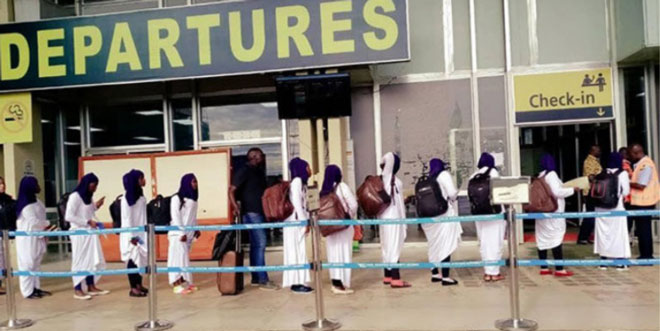
COMMENT | Samson Tinka | International labor migration has surged in recent years with an increasing number of workers moving across international borders for work. The stock of international migrants increased from 154 million in 1990 to 244 million in 2015 according to a UNDESA report. According to the International Labour Organisaation (ILO), migrant workers accounted for approximately 59% of the world’s international migrant population in 2017. Crossing national borders to work is one of the key motivation behind international migration mainly driven by economic inequalities, seeking employment or both.
On November 15, 2022, Amb. Abbey Walusimbi led a team of president’s office, aviation officiaals of CAA and security agencies to Entebbe international airport for a tour with the intention of familiarizing the team with the processes that migrant workers go through when going and when returning home.
Any effort geared towards streamlining labor externalization is a good one. As it is, we still have roadblocks as far as labor externalization processes, procedures and protocols are concerned. The challenges are end to end from passport acquisition, to training of labor migrants, vetting,screening, registration, transportation and remuneration.
Recruitment companies who are big stakeholders in this have their own challenges as well. From business formulation and starting to operations, relating with regulators, acquiring personnel, preparing them for prospective jobs and sourcing for reputable contracts.
The second last huddle is the movement of labor migrants from their respective companies to airport for onward movements to final destinations. The challenges are always found at the airport through vigorous clearances.
Already, the airport for a normal passenger is challenging, it has many security protocols to fulfill. Entebbe international airport has four security points where travelers must go through. These points may require passengers to disembark form their means of transport, go through walk through metal detectors, luggage through x-ray machines, removal of hand wristwatches, shoes and belts. This whole equation is tiresome but one must comply with it. For labor migrants, one must report to Ministry of labor desk on top of the procedures I have mentioned above.
The last box to tick is getting a job that you either paid for or you were promised at the final destination. One can clearly see that this process is not for the soft hearted. In all this we must acknowledge and submit that the unemployed and underemployed are everywhere in our country. Any opportunity that can take away numbers and reduce on unemployment should not only be welcomed, but also fully and decisively supported.
UBOS statistics on employment.
On Tuesday 15th Nov 2022, UBOS at a press conference revealed that the Ugandan employed earns sh200,000 on average. In the current economy, sh200,000 cannot facilitate the cost of living for an average family whether in urban setting or rural villages for over two weeks. Prices of common home goods have since touched the sky. Soap, sugar, cereals, posho, matooke, cassava prices have all run mad.
House helpers paid over 1m a month.
Now compare this with what is offered in the Middle East. In Saudi Arabia, where most Ugandan women go for employment, one is paid sh1million as the minimum remuneration. On top of this fee, the house cleaner is housed and transported. Therfore the sh1million is take home. Any person with good saving habits will come back to Uganda with close to sh20m after 2 years of tour of duty. This is not a small amount of money. If government can deal with inflation, this earning should be a deal cutter for ones improved future life.
Abu Dhabi, Qatar, Dubai secuirty agents earns 2.5m and above
This category of people earn above sh2m and other earn up to sh4 million depending on the role, the company that one works for. At the end of a 2year contract, this person has close to sh40million in the pocket. Ideally, sh40 million if well utilized should move someone from the poor bracket to what can be termed middle-income.
Lessons from other countries.
Based on figures from the year 2015, the countries holding the largest amount of such migrants are Saudi Arabia with 10.1 million, the United Arab Emirates (UAE) with 8 million, Kuwait with 2.8 million, Israel with 1.9 million, Oman with 1.8 million, Iran with 1.7 million, and Qatar with 1.6 million.
Nepal as an example.
More than 1,750 Nepalese leave the country daily for foreign employment. According to the data available a total of 6,39,167 aspirant migrant workers left for various countries in the fiscal year 2016/17, up from 4,18,713 in the previous FY 2015/16 . This figure does not include the population being employed in India, which is estimated to be more than 3 million. Massive increased in foreign labour migration, remittances flowing into Nepal as a share of GDP doubled from 14.9 per cent in 2005/06 to 32.1 per cent in 2015/16. Close to 50 per cent of Nepalese rely on financial help from relatives abroad, the highest rates in the region. The top-five destinations for Nepali migrant workers are Malaysia (40.9 %), Saudi Arabia (22.9 %), Qatar (20.3 %), United Arab Emirates (11.2 %) and Kuwait (2.1 %). Government data shows that a majority of the migrant Nepali workers are engaged in 4D works (Difficult, Dirty, Dangerous and demeaning) in countries, from Qatar to Malaysia and from South Korea to Israel .
Nepalese workers have sought foreign employment in both the agricultural and non-agricultural sectors and struggling to generate new employment opportunities. At the macro level, the remittances represent a valuable source of foreign currency. At the household level, remittances reduce poverty by providing much-needed money for basic necessities, such as food, clothes, health care and children’s education. Between 2005 and 2011, the poverty headcount in Nepal decreased by 4 per cent (from 29 to 25 %).
Nepal received remittance amounting to Rs. 875 billion in FY2019/20, which translates into a remittance to GDP ratio of 23.23 percent . Consequently, Nepal is seemingly a remittance-based country with remittance inflow amounting to more than a quarter of the country’s GDP. This is not small money. Imagine Nepal without migrant workers.
Recent data from the May Migration and Development Brief shows that remittance flows to Uganda declined by 26 per cent, from US$1.4 billion in 2019 to US$1.1 billion in 2020. Yet despite the decline, Uganda was ranked among the top ten recipient countries in sub-Saharan Africa.
Migrant workers has not just started today or yesterday especially for Arab countries. Some countries started these programs many years ago. Nepal, Philippines, Bangladesh, Pakistan, China, India, negotiated with Arab countries on better labor relations including renumeration,scope of work, and general contract terms including arbitration. Some countries like Philippines earn a lot of remittance from migrant workers more than anything in their countries. UAE non-core services/technical services are managed by non UAE nationals. The Philippines are allover UAE. They earn billions of dollars for their countries. Why not Ugandans?
Way forward for migrant workers in Uganda.
Ugandan government should accept that migrant workers journey is yet to stop and certainly will not stop. What’s needed is government is to quickly streamline the processes, protocols, policies to support labor migration. The benefits of labor migrations are in black and white. If there is a need of law, let Ministry of Labour come up with one. A streamlined labor migration with even kill off human trafficking, illegal labor movements among others.
One stop center for labour migration or externalization of labour.
Let’s borrow the concept of one stop center the government created to facilitate trade. When a business person arrives at malaba boarder, under one roof, you will find there URA,UNBS, banks, URSB and any other government agencies to facilitate trade. In the same spirit, there is a need for a venue where a migrant worker will find MOGLSD, passport officer, vetting offices, MOFA, ,representative of labour companies, security agencies name it. As it is now, these services are scattered. One has to move from here to there. Its tedious, frustrating and time consuming. As a country our customer services died long ago, we are never mindful of time as a cost, offices are easily closed on a working day etc. All these are bottlenecks towards growth and support of labor externalization.
One Ugandan working in Qatar supports more than five people back home. If you have 2 million labor workers in Arab world, it means 20 million Ugandans will benefit from this deployment.
To you Ambassador Walusimbi, keep your hands on tab for this sector. It is rewarding at an individual, family and country level. President Yoweri Museveni has big eyes, the fact that he has brought this sector to his office, means a lot. Any meaningful Ugandan leader at any level should support this sector. It has a potential to move our country from one level to another. Let us try it.
We need to see a seamless process from when one applies for a job to when the same person seats in Uganda airlines off to middle east. Of course other protocols like human rights, communication and evacuation can be debated.
We need to learn from how other countries have managed this sector. Certainly, issues of death, mistreatment of workers will come up. Modalities of how to handle these incidents should be in place.
We need to be objective, realistic, focused, bigger picture oriented than being unserious, alarmist and un-focused when dealing with issues of migrants. We need a developed Uganda by 2040. These are some of the risks we should prepare to take. A good Uganda for me now and a better Uganda for our children tomorrow. Both you and I have a role to play.
 Samson Tinka is a safety and security consultant | tindsam@yahoo
Samson Tinka is a safety and security consultant | tindsam@yahoo
 The Independent Uganda: You get the Truth we Pay the Price
The Independent Uganda: You get the Truth we Pay the Price



